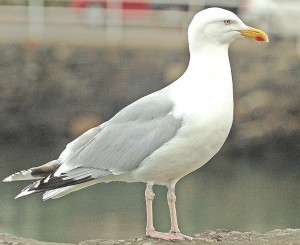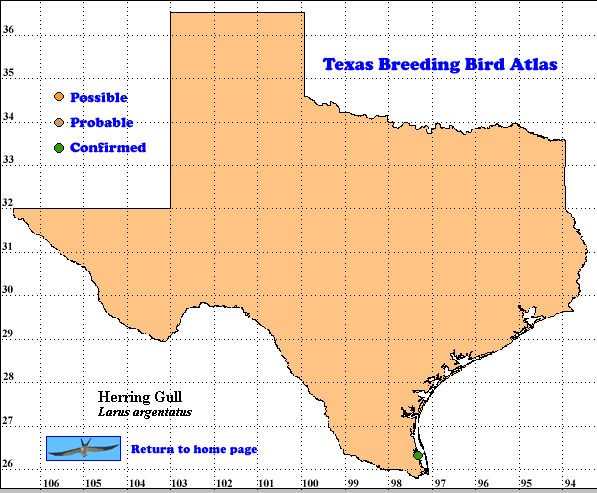Herring Gulls are perhaps the most common and familiar gulls of the northeast United States, eastern Canada and western Europe. They gulls inhabit shorelines of oceans, lakes, and large rivers. The identification and taxonomy of large white-headed gulls has always been challenging and controversial, complicated by their slow maturation and a succession of immature plumages. In addition hybrids between Herring Gulls and several other large, white-headed gulls like Glaucous-winged (L. glaucescens) and Lesser Black-backed (L. fuscus) gulls have been reported. (Pierotti and Good 1994).
Although Herring Gulls are opportunistic feeders, often seen at refuse dumps, most individuals feed primarily on natural foods such as fish and invertebrates. Individual gulls specialize in their foraging and this choice of diet influences breeding success. Ample food was probably a major factor enabling the Atlantic Coast population to recover from near extirpation by plume hunters in the late nineteen century (Pierotti and Good 1994).
DISTRIBUTION. During the 1987-1992 field work seasons of the TBBA project, an observer found a single confirmed breeding site in latilong-quad 26097-D3, probably the location on the Laguna Madre described by Lockwood and Freeman (2004). This breeding site is of speciao interest since North American Breeding Bird Survey (BSS) observers found most Herring Gulls from North Carolina to Newfoundland, along the St. Lawrence River, around the Great Lakes and major lakes in southern Manitoba. The highest relative abundances were 30-100 gulls per 40 km (25 mi) route in Nova Scotia and Newfoundland. Additional breeding was encountered in inland areas of Alberta and British Columbia (Sauer et al. 2008). Breeding has also been recorded north from these areas to the Arctic Ocean. In winter many breeders move south to the United States and Mexico. Other populations are found in the Old World (Pierotti and Good 1994, Howell and Webb 1995, Am. Ornithol. Union 1998).
SEASONAL OCCURRENCE. Herring Gulls are common migrants and winter residents along the coast and uncommon and local on the northeastern reservoirs in winter (mid-September to late April; Oberholser 1974, Lockwood and Freeman 2004). The breeding season for the occasional nesting is probably similar to that reported further north: May through August (Pierotti and Good 1994).
BREEDING HABITAT. The confirmed breeding site was on a spoil island in the shallow Laguna Madre (Lockwood and Freeman 2004). Across North America Herring Gulls prefer rocky or dry sand on major offshore islands, rocky islets, dredge tailings, marshy hummocks or barrier beaches. The pair scrapes a depression in the substrate and line it with vegetation, feathers or trash, adding more vegetation during incubation. In this nest the female usually lays 3 light to dark buff eggs, marked with black or dark brown speckles, spots or blotches. The eggs are laid at 2-day intervals. Incubation, by the female, starts when she lays the first egg.. The first 2 eggs hatch on day 30 with the third egg hatching 1-2 days later (Pierotti and Good 1994).
The down-covered chicks are semi-precocial. They are fed by parents and remain near the nest for a week until they can run freely. The chicks are brooded on cold or rainy days until they are 7-10 days old. They can fly by 45-50 days. The young are fed regurgitated food by their parents until they are 11-12 weeks old. While some chicks remain with their parents after this, many join groups around colonies and near abundant food sources such as refuse dumps, fishing activities or inter-tidal mudflats. Older immature gulls continue in groups separate from breeders until they reach breeding age, four years for males and five for females (Pierotti and Good 1994).
STATUS. Summering Herring Gulls are uncommon to rare along the Texas coast. Almost all are in very worm and bleached first- or second-year plumages (Lockwood and Freeman 2004). Since this species does not normally breed until acquiring full adult plumage, the actual number of potential breeding adults in summer in Texas is exceedingly small. BBS data for North America provides a statistically significant -3.2% annual population change for Herring Gulls for 1980-2007 (Sauer et al. 2008). Inn spite of this surprisingly large annual decline, the large wintering and migrant population in Texas and the adaptability of this gull to human environments, suggests it will continue to be present in Texas far into the future.
Text by Robert C. Tweit (2008)
Literature cited.
American Ornithologists’ Union. 1998. Checklist of North American birds, 7th ed. Am, Ornithol. Union, Washington, DC.
Howell, S. N. G. and S. Webb. 1995. A guide to the birds of Mexico and northern Central America. Oxford University Press, New York.
Lockwood, M. W. and B. Freeman. 2004. The TOS handbook of Texas birds. Texas A&M University Press, College Station.
Oberholser, H. C. 1974. The bird life of Texas. University of Texas Press, Austin.
Pierotti, R. J. and T. P. Good. 1994. Herring Gull (Larus argentatus), The Birds of North America Online (A. Poole, Ed.). Cornell Lab of Ornithology; Ithaca, NY. Retrieved from: : http://bna.birds.cornell.edu/bna/species/124
Sauer, J. R., J. E. Hines, and J. Fallon. 2008. The North American breeding bird survey, results and analysis 1966-2007. Version 5.15.2008. USGS Patuxent Wildlife Research Center, Laurel MD < http://www.mbr-pwrc.usgs.gov/bbs>

